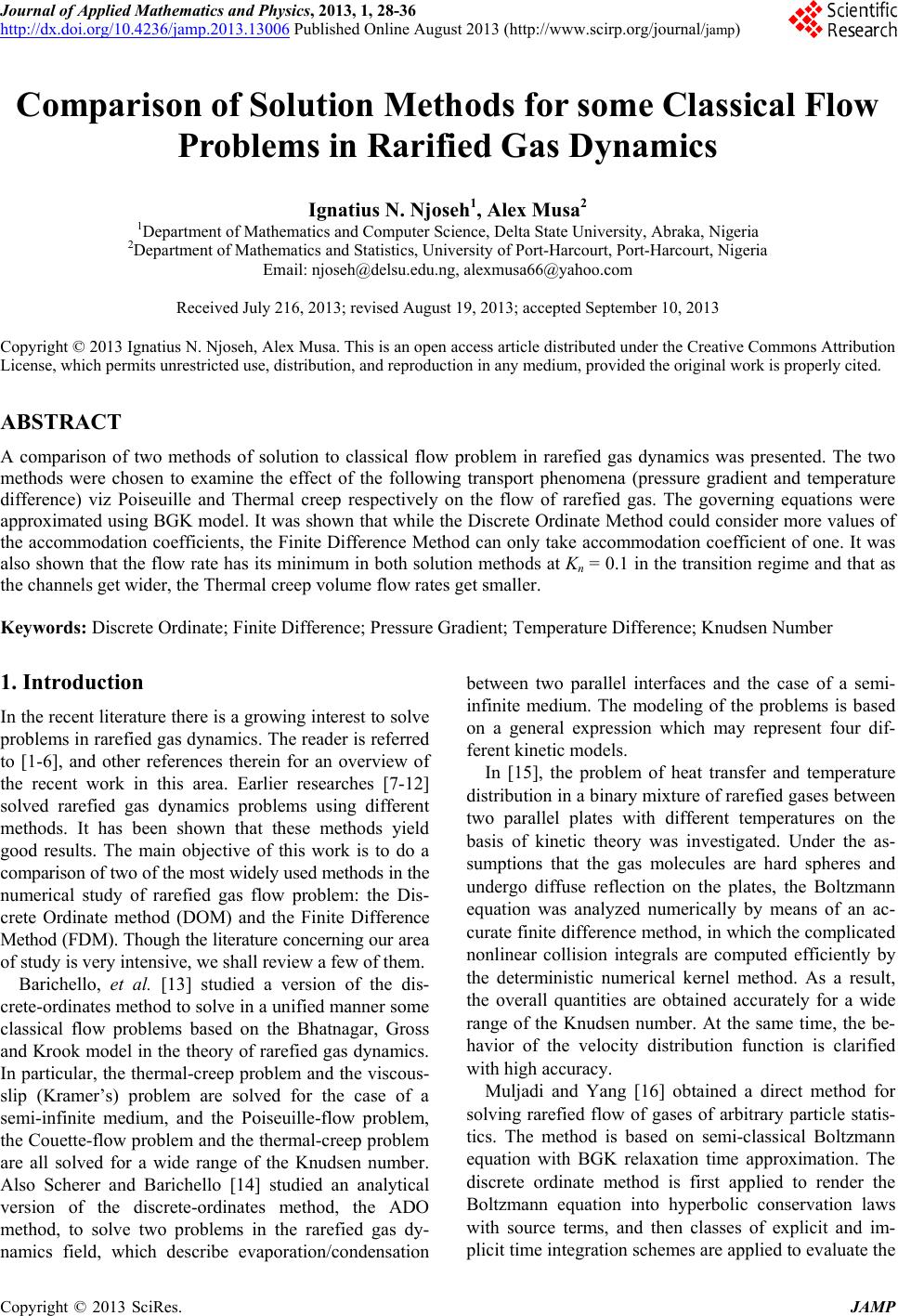 Journal of Applied Mathematics and Physics, 2013, 1, 28-36 http://dx.doi.org/10.4236/jamp.2013.13006 Published Online August 2013 (http://www.scirp.org/journal/jamp) Comparison of Solution Methods for some Classical Flow Problems in Rarified Gas Dynamics Ignatius N. Njoseh1, Alex Musa2 1Department of Mathematics and Computer Science, Delta State University, Abraka, Nigeria 2Department of Mathematics and Statistics, University of Port-Harcourt, Port-Harcourt, Nigeria Email: njoseh@delsu.edu.ng, alexmusa66@yahoo.com Received July 216, 2013; revised August 19, 2013; accepted September 10, 2013 Copyright © 2013 Ignatius N. Njoseh, Alex Musa. This is an open access article distributed under the Creative Commons Attribution License, which permits unrestricted use, distribution, and reproduction in any medium, provided the original work is properly cited. ABSTRACT A comparison of two methods of solution to classical flow problem in rarefied gas dynamics was presented. The two methods were chosen to examine the effect of the following transport phenomena (pressure gradient and temperature difference) viz Poiseuille and Thermal creep respectively on the flow of rarefied gas. The governing equations were approximated using BGK model. It was shown that while the Discrete Ordinate Method could consider more values of the accommodation coefficients, the Finite Difference Method can only take accommodation coefficient of one. It was also shown that the flow rate has its minimum in both solution methods at Kn = 0.1 in the transition regime and that as the channels get wider, the Thermal creep volume flow rates get smaller. Keywords: Discrete Ordinate; Finite Difference; Pressure Gradient; Temperature Difference; Knudsen Number 1. Introduction In the recent literature there is a growing interest to solve problems in rarefied gas dynamics. The reader is referred to [1-6], and other references therein for an overview of the recent work in this area. Earlier researches [7-12] solved rarefied gas dynamics problems using different methods. It has been shown that these methods yield good results. The main objective of this work is to do a comparison of two of the most widely used methods in the numerical study of rarefied gas flow problem: the Dis- crete Ordinate method (DOM) and the Finite Difference Method (FDM). Though the literature concerning our area of study is very intensive, we shall review a few of them. Barichello, et al. [13] studied a version of the dis- crete-ordinates method to solve in a unified manner some classical flow problems based on the Bhatnagar, Gross and Krook model in the theory of rarefied gas dynamics. In particular, the thermal-creep problem and the viscous- slip (Kramer’s) problem are solved for the case of a semi-infinite medium, and the Poiseuille-flow problem, the Couette-flow problem and the thermal-creep problem are all solved for a wide range of the Knudsen number. Also Scherer and Barichello [14] studied an analytical version of the discrete-ordinates method, the ADO method, to solve two problems in the rarefied gas dy- namics field, which describe evaporation/condensation between two parallel interfaces and the case of a semi- infinite medium. The modeling of the problems is based on a general expression which may represent four dif- ferent kinetic models. In [15], the problem of heat transfer and temperature distribution in a binary mixture of rarefied gases between two parallel plates with different temperatures on the basis of kinetic theory was investigated. Under the as- sumptions that the gas molecules are hard spheres and undergo diffuse reflection on the plates, the Boltzmann equation was analyzed numerically by means of an ac- curate finite difference method, in which the complicated nonlinear collision integrals are computed efficiently by the deterministic numerical kernel method. As a result, the overall quantities are obtained accurately for a wide range of the Knudsen number. At the same time, the be- havior of the velocity distribution function is clarified with high accuracy. Muljadi and Yang [16] obtained a direct method for solving rarefied flow of gases of arbitrary particle statis- tics. The method is based on semi-classical Boltzmann equation with BGK relaxation time approximation. The discrete ordinate method is first applied to render the Boltzmann equation into hyperbolic conservation laws with source terms, and then classes of explicit and im- plicit time integration sch emes are applied to evalu ate the C opyright © 2013 SciRes. JAMP 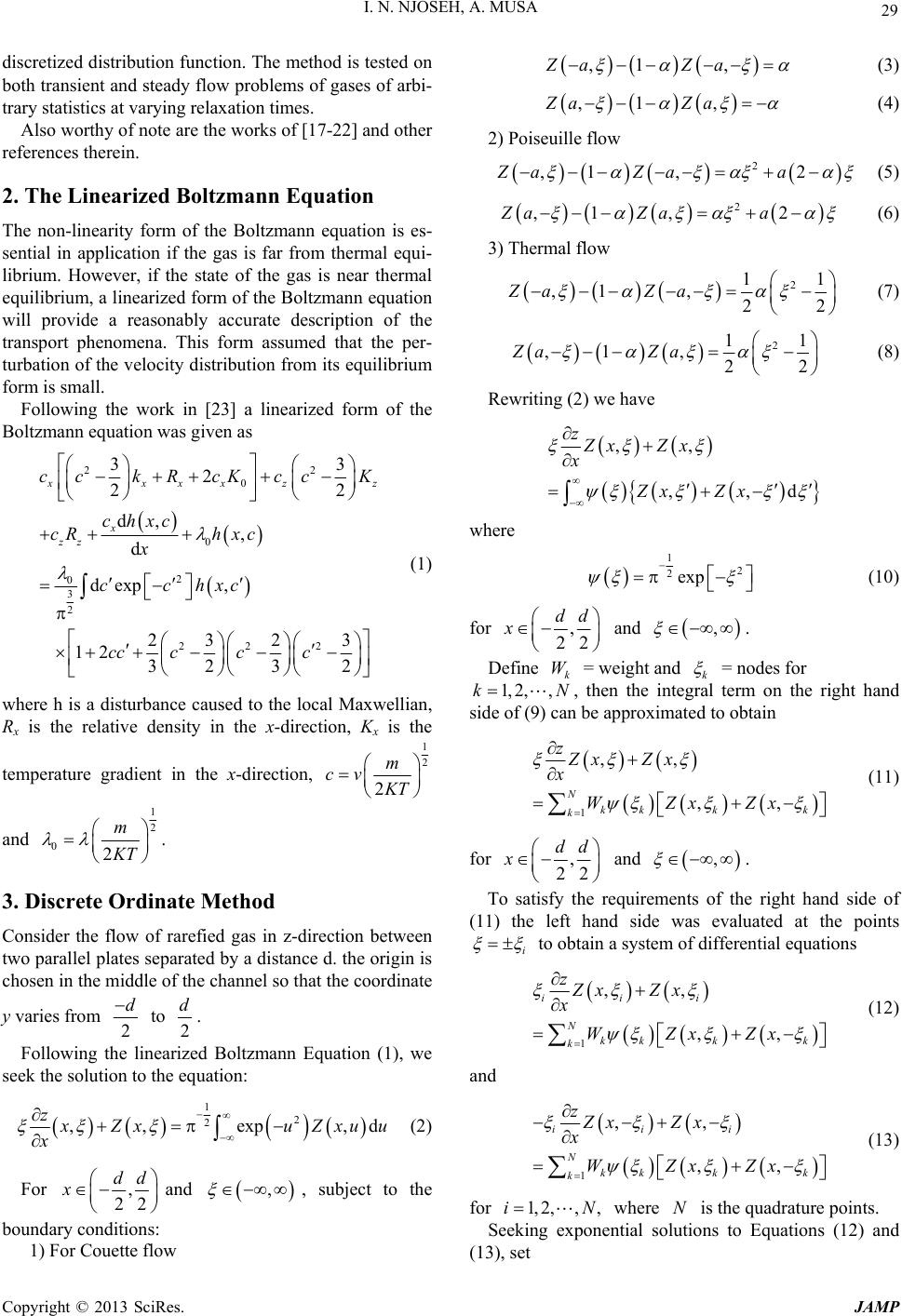 I. N. NJOSEH, A. MUSA 29 discretized distribution function. The method is tested on both transient and steady flow problems of gases of arbi- trary statistics at varying relaxation times. Also worthy of no te are th e work s of [17- 22] and oth er references therein. 2. The Linearized Boltzmann Equation The non-linearity form of the Boltzmann equation is es- sential in application if the gas is far from thermal equi- librium. However, if the state of the gas is near thermal equilibrium, a linearized form of the Boltzmann equation will provide a reasonably accurate description of the transport phenomena. This form assumed that the per- turbation of the velocity distribu tion from its equilibrium form is small. Following the work in [23] a linearized form of the Boltzma nn e qu at i on was given as 22 0 0 2 0 3 2 22 2 33 2 22 d, , d dexp , 23 23 12 32 32 xx xz x zz cckR cK ccK chxc cRh xc x cchxc ccccc z (1) where h is a disturbance caused to the local Maxwellian, Rx is the relative density in the x-direction, Kx is the temperature gradient in the x-direction, 1 2 2 m cv T and 1 2 02 m T . 3. Discrete Ordinate Method Consider the flow of rarefied gas in z-direction between two parallel plates separated by a distance d. the orig in is chosen in the middle of the channel so that the coordinate y varies from 2 d to 2 d. Following the linearized Boltzmann Equation (1), we seek the solution to the equation: 12 2 ,,exp , zd Zxu Zxu u x (2) For , 22 dd x and , , subject to the boundary conditions: 1) For Couette flow ,1 ,Za Za (3) ,1 ,Za Za (4) 2) Poiseuille flow 2 ,1 ,2Za Zaa (5) 2 ,1 ,2ZaZa a (6) 3) Thermal flow 2 1 ,1, 22 Za Za 1 (7) 2 1 ,1, 22 Za Za 1 (8) Rewriting (2) we have ,, ,,d zZx Zx x Zx Zx where 12 2exp (10) for , 22 dd x and , . Define = weight and kk W = nodes for 1, 2,k,N , then the integral term on the right hand side of (9) can be approximated to obtain 1 ,, ,, N kk kk k zZx Zx x WZxZx (11) for , 22 dd x and , . To satisfy the requirements of the right hand side of (11) the left hand side was evaluated at the points i to obtain a system of differential equatio ns 1 ,, ,, iii N kk kk k zZx Zx x WZxZx (12) and 1 ,, ,, iii N kk kk k zZx Zx x WZxZx (13) for 1, 2,,,iN where is the quadrature points. N Seeking exponential solutions to Equations (12) and (13), set Copyright © 2013 SciRes. JAMP 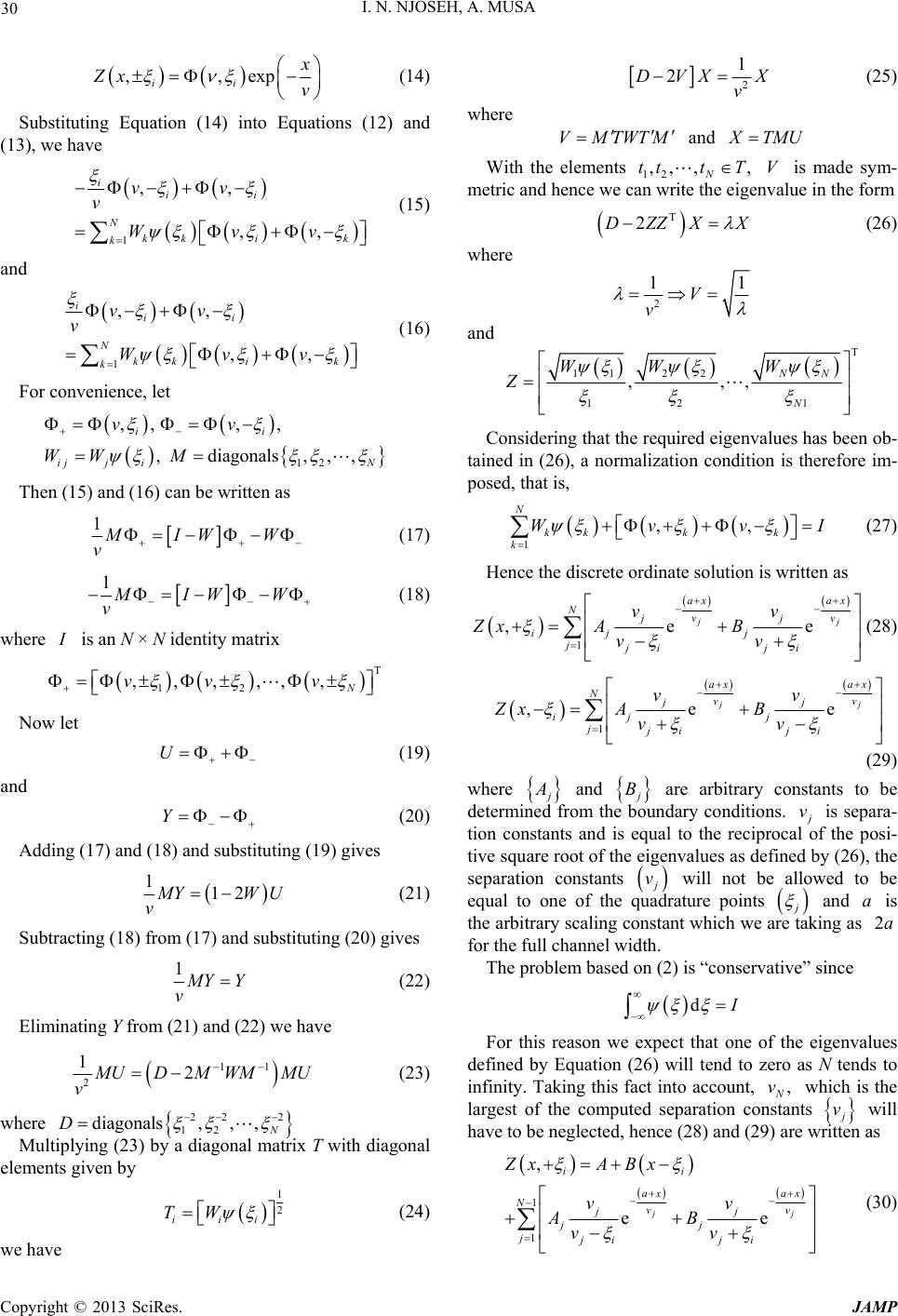 I. N. NJOSEH, A. MUSA 30 ,,exp ii Zx v (14) Substituting Equation (14) into Equations (12) and (13), we have 1 ,, ,, i ii N kk i k k vv v Wvv (15) and 1 ,, ,, i ii N kk ik k vv v Wvv (16) For convenience, let ,, i v 12 , , ,diagonals, ,, i ijj iN v WWM Then (15) and (16) can be written as 1MIWW v (17) 1MIWW v (18) where is an N × N identity matrix Now let (19) and (20) Adding (17) and (18) and substi ,,,,,vv T 12, N v U Y tuting (19) gives 112 YWU v (21) Subtracting (18) from (17) and substitutin g (20) gives 1 YY v (22) Eliminating Y from (21) an d (22) we ha v e 11 1 22 UDMWMMU v (23) where T with diagonal 22 2 12 diagonals,,, N D iplying (23) by a diagonal matriMultx elements given by 1 2 iii TW 2 1 2DVX X v (25) where VMTWTM and TMU With the elements isade sym- m12 ,, ,tt T n write the eigenv , N t mV aetric and hence we calue in the form T 2DZZX X (26) where 2 11 V v and T 112 2 12 1 ,,, NN N W WW Z Considering that the required eigenvalues has been ob- ta I ined in (26), a normalization condition is therefore im- posed, that is, N W 1 ,, kk k k k vv (27) Hence the discrete ordinate solution is written as 1 ,ee jj jj ij j jji ji Zx A B vv ax ax Nvv vv (28) 1 ,e jj ax ax Nvv jj ij j jjiji vv Zx AB vv e (29) where and Bou are arbitrary constants to be determinrom the bndary conditions. ed f v is separa- tion constants and is equal to the reciprocaf the posi- tive square root of the eigenvalues as defined by (26), the separation constants l o v will not be allowed to be equal to one of the qrature points uad and a is the arbitrary scaling constant which we aring as 2a for the full chann el width. The problem based on (2) is “conservative” since e tak d For this reason we expect that one of the eigenvalues defined by Equation (26) will tend to zero as N tends to infinity. Taking this fact into account, , v which is the largest of the computed separation conts stan v will have to be neglected, hence (28) and (29) are written as 1 1 ,ii ZxA Bx ee jj ax ax Nvv jj jj jji ji vv AB vv (24) we have (30) Copyright © 2013 SciRes. JAMP 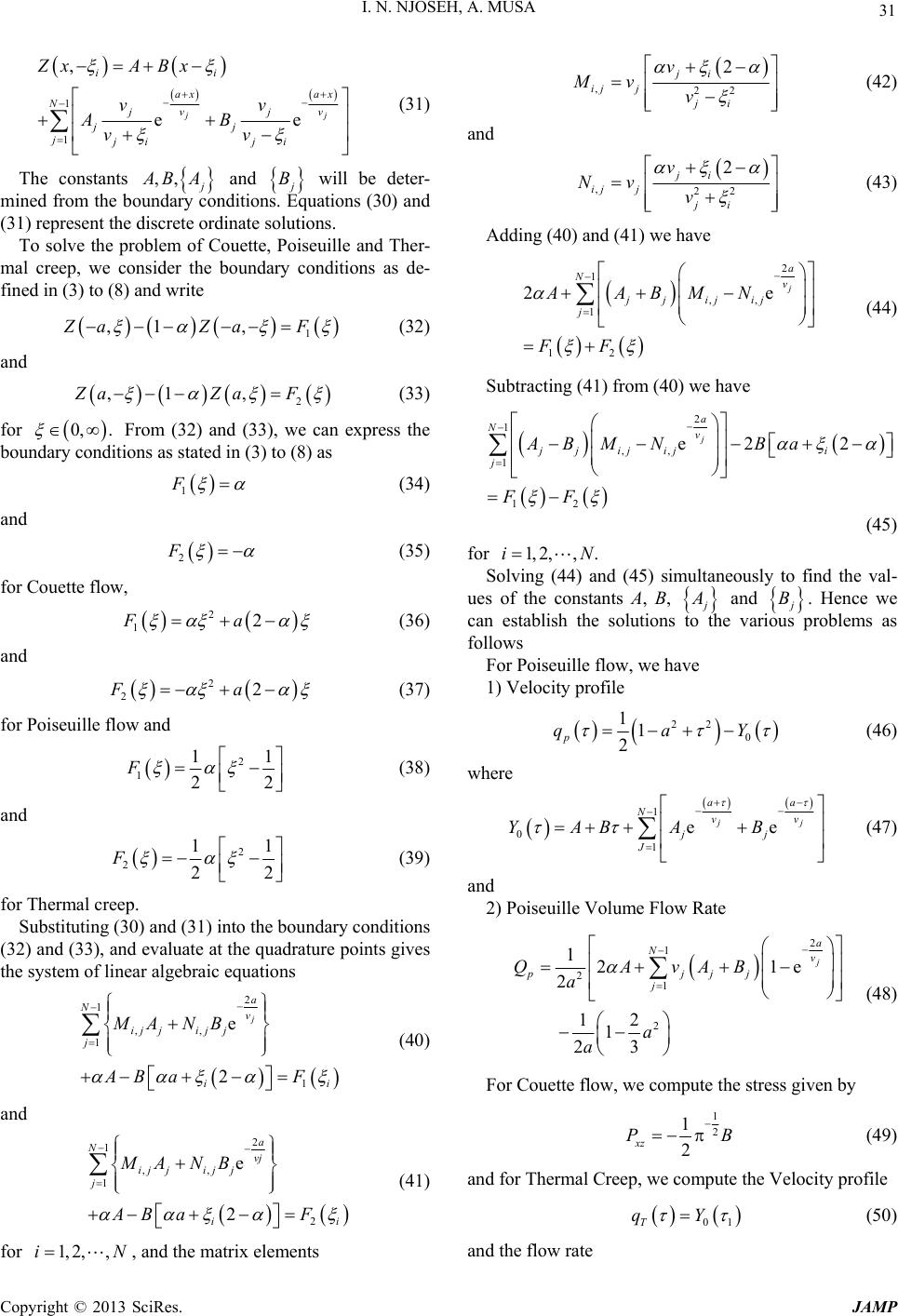 I. N. NJOSEH, A. MUSA 31 1 1 , ee jj ii ax ax Nvv jj jj jjiji ZxA Bx vv AB vv The constants (31) ,, BA and B itions. Equat will be deter- mined fromions (30) and (31) represent the discrete ordinate solutions. To solve the problem of Couette, Poiseuille and Ther- mal creep, we consider the boundary conditions as de- finnd write the boundary cond ed in (3) to (8) a 1 ,1 ,ZaZaF (32) and 2 ,1 ,ZaZa F (33) for From (32) and (33), we can bouitions as stated in (3) to (8) as 0, . ndary cond express the 1 F (34) and 2 F (35) for Couette flow, 2 12Fa (36) and 2 F 22a (37) for Poiseuille flow and 2 111 22 F (38) and 2 211 2 F 2 (39) for Thermal creep. bstituting (30) and (31) into the boundary conditions (32) and (33), and evaluate at the quadrature points gives the system of linear algebraic equation Su s ,, 1 1 2 ij jij j j i AB a F 2 ej a v i A NB 1 N M and (40) 2 1 ,, 1 2 e 2 a N vj ij jij j j ii MA NB AB aF (41) for , and the matrix elements 1, 2,,iN ,22 2 ji ij j ji v Mv v (42) and ,22 2 ji v v ij j ji Nv (43) Adding (40) and (41) we have 2 1 ,, 1 12 2e j a Nv jj ijij j AABMN FF ave (44) Subtracting (41) from (40) we h 2 1 ,, 1 12 e2 j a Nv j jijij j AB MNBa FF 2 i (45) for 1, 2,,.iN Solving (44) and (45) simultaneously to find the val- ues of the constants A, B, and B rious pr . Hence we can establish the solutions t vaoblems as follows For Poiseuille flow, we have Velocity profile o the 1) 22 0 11 2 p qaY (46) where 1N 0 YAB 1 ee jj aa vv jj J A B (47) and iseuille Volume Flow Rate 2) Po 2 1 21 2 121 2 12 1 e j a Nv pjjj j QAvAB a 23 a a (48) For Couette flow, we compute the stress given by 1 2 1 2 xz PB and for Thermal Creep, we compute the Velocity profile (49) 01T qY (50) and the flow rate Copyright © 2013 SciRes. JAMP  I. N. NJOSEH, A. MUSA 32 2 1 2 121 2 a N Tjj QAvA a 4. Finite Difference Method zed two dimensional approach in [7] with the Bhatnagar-Gross-Krook Model (BGK) in [24, 25], the Boltzmann equation to be solved is reduce 1 j e j v j B (51) Using the lineari d to 2 0 3 2222 0 3 22 d exp 2 zz xyz hq h yz qF h Fh m hkT 0 20 3d 2hv F d z F (52) where relativechangein velocity distribution function ,,the molecular volecity ,,the ga s ve lo city relative change in the particle density lative change in temperature the collision f xyz xyz qq q q re requency The perturbation terms and depend only on z (flow direction) and are related to the pressure and temperature gradient. They are 21 , zz Tkv k dd where is proportional to pressure gradient and is boundary conditions are: 1 k 2 k proportional to temperature gradient, and both are small compared to unity. The velocity of the reflecting molecules from the wall is specified by the Maxwellian distribution; then the 2 122 13 Sgn, , 22 y zz dzkk kh dd (53) where 1, if0 Sgn 1, if0 y y A solution in the form y 01 ,, , z zy d (54 was sought where ) 2 0125 2 kkh (55) Substituting Equation (54) into Equation (52) we have 1 d, d yy y 2 12 52 2 kk hh q z zdd (56) Multiplying both sides of Equation (56) by 22 exp zzx hh and integrating over fu ll ranges, we have 2 12 2 d1 2 d2 yz kkk F y hq h yh ddd (57) where the function F is defined by 22 1 ,exp , dd zx h Fyhy yxz (58) oundary condi- tions Integrating Equation (57) under the b 11Sgn, ,0 2y dz (59) we have 1112 2 sgn 22 ex ydd d , 2 22 1 p d y y d yzy y Fy kk k hhq h yt he gas velocity qz is expressed by (60) When t 1 22 sgnexp d yy h qyFh (61) Equation (61) now re duces to 1 2 11 12 1 222 11 1 2 22 1 1 d 22 d z d d d hq y 1 2 22 2 11 z d kk 22 2 hythqt t dh dh kJhytt (62) dh Copyright © 2013 SciRes. JAMP  I. N. NJOSEH, A. MUSA 33 n where is defined by 2 0exp d n n x yy y y Let 1 21 2 2,dh 11 22 , ,yh yT dht 1 11 22 12 1 21 2 zp hq dhkk T (63) then Equation (62) will be written as two integral e quations, i.e., 11 2 22 1 2 d1 d pp d hytt (64) and 11 2 22 1 2 11 2 22 1 1d 2 d d 2 d d TT d hytt where Jhytt (65) the inverse Knudsen number From induc Equation (63), we have the velocity of the gas ed by the pressure gradient as, 1 2 1 21 2 P hq P (66) and that induced by temperature gradient as 1 2 1 21 22 TT hq (67) The volume flow rate is then given by 2 2 11 2 d d d Pz P d Gqyy p z 22 22 2d 2 4hd d (68) 2 2 Tz T d 11 222 20 22 d d d 4d 4 d T Gpqyy T hnkdz (69) Expressing Equations (68) and (69) in non-dimen- sional for m gives; 1 12 2 1 2 2d 24 x PP x Q (70) and 1 12 2 1 2 2d 44 x TT Q x (71) ectively. Next, is to solve numerically the unknown functions The subscripts P and T imply Poiseuille flow and Thermal creep resp and T r to s in Equations (64) and (65) ordeolve Equations (64) and ( ference method was utilized after discretization as respectively. 65), a finite dif- In 11 21 11 0 1d1 2 k k n PhPkn n k J (72) 11 2 12 2 211 22 nn 1 11 0 1 2 11 d k k n ThTkn n k J J d (73) where k is the stepwise function of and Tk e stepwise function of T th he consnt value of th e functions Tta k and Tk on each interval is interpreted as the value at the midpoint. The transcendental function T has a singularity when According to the obvious way of differences, tions (72) and (73) reduce to the matrix 0.x Equa- 1 01 for 0,1,2,,1 n hk pk k nn (74) 1 0 for 0,1,2 ,,1 Tk n hk h k Bgn n (75) where 22 1 2 222 2 121 d 2 kn n kn n hk hk hn AJ n (76) hk hk B (77) 1 2 2 21 121 d 22 h hn gJ n (78) Integrating Equations (76) and (78) using ties of the proper- n we have; Copyright © 2013 SciRes. JAMP 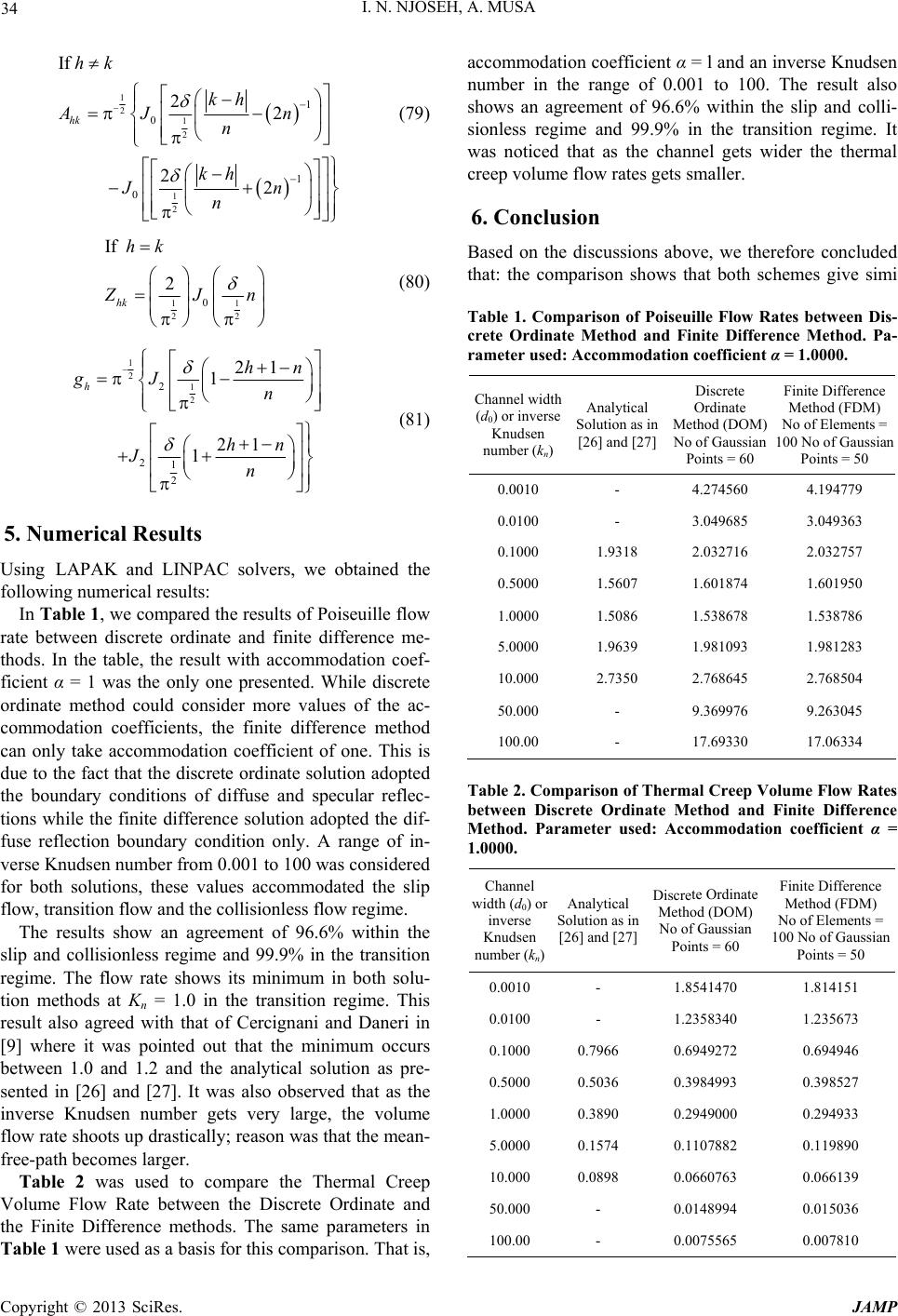 I. N. NJOSEH, A. MUSA 34 1 21 2 1 2 1 0 1 0 If 22 22 hk hk kh AJ n n kh Jn n (79) 11 22 0hk If 2 hk Jn (80) 1 21 2 2 21 2 21 1 21 1 h hn gJ n hn Jn 5. Numerical Results Using LAPAK and LINPAC solvers, we obtained the following numerical results: In Ta ble 1, we compared the results of Poiseuille flow rate between discrete ordinate and finite difference me thods. In the table, the result with accommodation coef- ficient α = 1 was the only one presented. While discrete ordinate method could consider more values of the ac- commodation coefficients, the finite diffe can only take accommodation coefficient of one. This is due to the fact that the discrete ordinate solution adopted the boundary conditions of diffuse and specular reflec- tions while the finite difference solution adopted the dif- ndition only. A range of in- T (81) - rence method fuse reflection boundary co verse Knudsen number from 0.001 to 100 was considered for both solutions, these values accommodated the slip flow, transition flow and the collisionless flow regime. The results show an agreement of 96.6% within the slip and collisionless regime and 99.9% in the transition regime. The flow rate shows its minimum in both solu- tion methods at Kn = 1.0 in the transition regime. This result also agreed with that of Cercignani and Daneri in [9] where it was pointed out that the minimum occurs between 1.0 and 1.2 and the analytical solution as pre- sented in [26] and [27]. It was also observed that as the inverse Knudsen number gets very large, the volume flow rate shoots up drastically; reason was that the mean- free-path becomes larger. Table 2 was used to compare the Thermal Creep Volume Flow Rate between the Discrete Ordinate and the Finite Difference methods. The same parameters in able 1 were used as a basis for this comparison. That is, accommodation coefficient α = l and an inverse Knudsen number in the range of 0.001 to 100. The result also shows an agreement of 96.6% within the slip and colli- sionless regime and 99.9% in the transition regime. It was noticed that as the channel gets wider the thermal creep volume flow rates gets smaller. 6. Conclusion Based on the discussions above, we therefore concluded that: the comparison shows that both schemes give simi Table 1. Comparison of Poiseuille Flow Rates between Dis- crete Ordinate Method and Finite Difference Method. Pa- rameter used: Accommodation coefficient α = 1.0000. Channel width (d0) or inverse Knudsen number (kn) Analytical Solution as in [26] and [27] Discrete Ordinate Method (DOM) No of Gaussian Points = 60 Finite Difference Method (FDM) No of Elements = 100 No of Gaussian Points = 50 0.0010 - 4.274560 4.194779 0.0100 - 3.049685 3.049363 1.0000 1.5086 1.538678 1.538786 4 0.1000 1.9318 2.032716 2.032757 0.5000 1.5607 1.601874 1.601950 5.0000 1.9639 1.981093 1.981283 10.000 2.7350 2.768645 2.76850 50.000 100.00 - - 9.369976 17.69330 9.263045 17.06334 Table 2. Comparison of Thermal Creep Volume Flow Rates betwiscrete Oinate Md Finince Merametersed: Acc coα = 1.0000. Channel wid inver K num Ana Solution as in [26] a Discre Method ( No of Points = 60 Finite Difference Me) No o 100 No of Gaussian P een Drdethod ante Differe thod. Pa uommodationefficient th (d0) or se nudsen ber (kn) lytical nd [27] te Ordinate DOM) Gaussian thod (FDM f Elements = oints = 50 01.8.0010 - 541470 1.814151 0- 1.2 00.7966 0.6 0.5000 0.5036 0.3984993 0.398527 0898 0.0660763 0.066139 50.000 - 0.0148994 0.015036 100.00 - 0.0075565 0.007810 .0100 358340 1.235673 .1000 949272 0.694946 1.0000 0.3890 0.2949000 0.294933 5.0000 0.1574 0.1107882 0.119890 10.000 0. Copyright © 2013 SciRes. JAMP 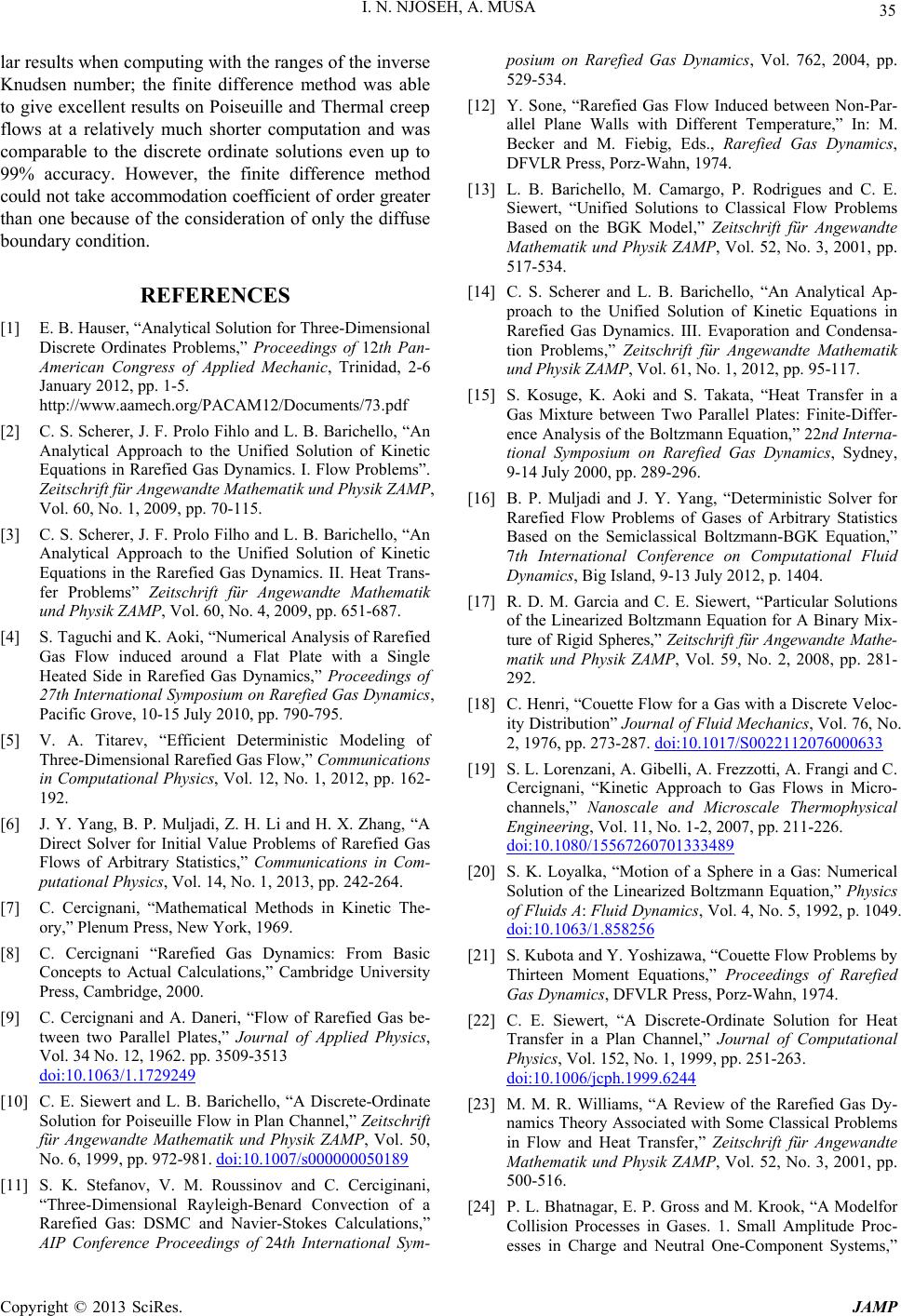 I. N. NJOSEH, A. MUSA 35 la when computinge m m toc n fch m comparable to the discrete ordinate solutions even up to 99% accuracy. However, differ could not take accommodatient of order greater than onebecause consi bo cond FERS [1] Haualyticaor Three-Dimensional icanss of chanic, ary 2012p. 1-5. aamech.org/PACAM [2] Schere. F. Prol L. B. B“An . Aoki, “Numerical Analysis of Rarefied Gas Flow induced around a Flat Plate with a Single Heated Side ins,” Proceedings of 27th Internatiofied Gas Dynamics r results Knudsen nu give ex lows at a r with the rang nite difference es of the invers ethod was ab ber; the fi ellent results elatively mu le on Poiseuille a shorter cod Thermal creep putation and was the finiteence method ion coeffic undary of the ition. deration of only the diffuse RE ENCE E. B.ser, “Anl Solution f Discrete Ordinates Problems,” Amer Proceedings Applied Me of 12th Pan- Trinidad, Congre 2-6 Janu http://www. , p12/Documents/73.pdf C. S.r, Jo Fihlo andarichello, Analytical Approach to the Unified Solution of Kinetic Equations in Rarefied Gas Dynamics. I. Flow Problems”. Zeitschrift für Angewandte Mathematik und Physik ZAMP, Vol. 60, No. 1, 2009, pp. 70-115. [3] C. S. Scherer, J. F. Prolo Filho and L. B. Ba richello, “An Analytical Approach to the Unified Solution of Kinetic Equations in the Rarefied Gas Dynamics. II. Heat Trans- fer Problems” Zeitschrift für Angewandte Mathematik und Physik ZAMP, Vol. 60, No. 4, 2009, pp. 651-687. [4] S. Taguchi and K Rarefied Gas Dynamic nal Symposium on Rare, Pacific Grove, 10-15 July 2010, pp. 790-795. [5] V. A. Titarev, “Efficient Deterministic Modeling of Three-Dimensional Rarefied Gas Flow,” Communications in Computational Physics, Vol. 12, No. 1, 2012, pp. 162- 192. [6] J. Y. Yang, B. P. Muljadi, Z. H. Li and H. X. Zhang, “A Direct Solver for Initial Value Problems of Rarefied Gas Flows of Arbitrary Statistics,” Communications in Com- putational Physics, Vol. 14, No. 1, 2013, pp. 242-264. C. Cercignani, “Mathematical M[7] ethods in Kinetic The- ory,” Plenum Press, New York, 1969. [8] C. Cercignani “Rarefied Gas Dynamics: From Basic Concepts to Actual Calculations,” Cambridge University Press, Cambridge, 2000. [9] C. Cercignani and A. Daneri, “Flow of Rarefied Gas be- tween two Parallel Plates,” Journal of Applied Physics, Vol. 34 No. 12, 1962. pp. 3509-3513 doi:10.1063/1.1729249 [10] C. E. Siewert and L. B. Barichello, “A Discrete-Ordinate Solution for Poiseuille Flow in Plan Channel,” Zeitschrift für Angewandte Mathematik und Physik ZAMP, Vol. 50, No. 6, 1999, pp. 972-981. doi:10.1007/s000000050189 [11] S. K. Stefanov, V. M. Roussinov and C. Cerciginani, p. between Non-Par- , 2001, pp. “Three-Dimensional Rayleigh-Benard Convection of a Rarefied Gas: DSMC and Navier-Stokes Calculations,” AIP Conference Proceedings of 24th International Sym- posium on Rarefied Gas Dynamics, Vol. 762, 2004, p 529-534. [12] Y. Sone, “Rarefied Gas Flow Induced allel Plane Walls with Different Temperature,” In: M. Becker and M. Fiebig, Eds., Rarefied Gas Dynamics, DFVLR Press, Porz-Wahn, 1974. [13] L. B. Barichello, M. Camargo, P. Rodrigues and C. E. Siewert, “Unified Solutions to Classical Flow Problems Based on the BGK Model,” Zeitschrift für Angewandte Mathematik und Physik ZAMP, Vol. 52, No. 3 517-534. [14] C. S. Scherer and L. B. Barichello, “An Analytical Ap- proach to the Unified Solution of Kinetic Equations in Rarefied Gas Dynamics. III. Evaporation and Condensa- tion Problems,” Zeitschrift für Angewandte Mathematik und Physik ZAMP, Vol. 61, No. 1, 2012, pp. 95-117. [15] S. Kosuge, K. Aoki and S. Takata, “Heat Transfer in a Gas Mixture between Two Parallel Plates: Finite-Differ- ence Analysis of the Boltzmann Equation,” 22nd Interna- tional Symposium on Rarefied Gas Dynamics, Sydney, 9-14 July 2000, pp. 289-296. [16] B. P. Muljadi and J. Y. Yang, “Deterministic Solver for Rarefied Flow Problems of Gases of Arbitrary Statistics Based on the Semiclassical Boltzmann-BGK Equation,” 7th International Conference on Computational Fluid Dynamics, Big Island, 9-13 July 2012, p. 1404. [17] R. D. M. Garcia and C. E. Siewert, “Particular Solutions of the Linearized Boltzmann Equation for A Binary Mix- ture of Rigid Spheres,” Zeitschrift für Angewandte Mathe- matik und Physik ZAMP, Vol. 59, No. 2, 2008, pp. 281- 292. [18] C. Henri, “Couette Flow for a Gas with a Discrete Veloc- ity Distribution” Journal of Fluid Mechanics, Vol. 76, No. 2, 1976, pp. 273-287. doi:10.1017/S0022112076000633 [19] S. L. Lorenzani, A. Gibelli, A. Frezzotti, A. Frangi and C. Cercignani, “Kinetic Approach to Gas Flows in Micro- channels,” Nanoscale and Microscale Thermophysical Engineering, Vol. 11, No. 1-2, 2007, pp. 211-226. doi:10.1080/15567260701333489 [20] S. K. Loyalka, “Motion of a Sphere in a Gas: Numerical Solution of the Linearized Boltzmann Equation,” Physics of Fluids A: Fluid Dynamics, Vol. 4, No. 5, 1992, p. 1049. doi:10.1063/1.858256 [21] S. Kubota and Y. Yoshizawa, “Couette Flow Problems by cs, Vol. 152, No. 1, 1999, pp. 251-263. Thirteen Moment Equations,” Proceedings of Rarefied Gas Dynamics, DFVLR Press, Porz-Wahn, 1974. [22] C. E. Siewert, “A Discrete-Ordinate Solution for Heat Transfer in a Plan Channel,” Journal of Computational Physi doi:10.1006/jcph.1999.6244 [23] M. M. R. Williams, “A Review of the Rarefied Gas Dy- namics Theory Associated with Some Classical Problems elfor mall Amplitude Proc- in Flow and Heat Transfer,” Zeitschrift für Angewandte Mathematik und Physik ZAMP, Vol. 52, No. 3, 2001, pp. 500-516. [24] P. L. Bhatnagar, E. P. Gross and M. Krook, “A Mod Collision Processes in Gases. 1. S esses in Charge and Neutral One-Component Systems,” Copyright © 2013 SciRes. JAMP  I. N. NJOSEH, A. MUSA Copyright © 2013 SciRes. JAMP 36 arefied Gas Past a Sphere on Physical Review, Vol. 94, No. 3, 1954, pp. 511-525. [25] S. Takata, Y. Sone and K. Aoki, “ Numerical Analysis of a Uniform Flow of a Rthe Basis of the Boltzmann Equation for Hard-Sphere Mole- cules,” Physics of Fluids A: Fluid Dynamics, Vol. 5, No. 3, 1993, p. 716. doi:10.1063/1.858655 [26] S. K. Lokalka and K. A. Hickey, “Kinetic Theory of Thermal Transpiration and Mechanocaloric Effect: Planar Flow of a Rigid Sphere Gas with Arbitrary Accommoda- tion at the Surface,” Journal of Vacuum Science & Tech- nology A, Vol. 9, No. 1, 1991, p. 158. doi:10.1116/1.577119 [27] D. Valougeorgis, “An Analytic Solution of S-Model Ki- netic Equations,” Zeitschrift für Angewandte Mathematik und Physik ZAMP, Vol. 54, No. 1, 2003, pp. 112-124. doi:10.1007/PL00012627
|